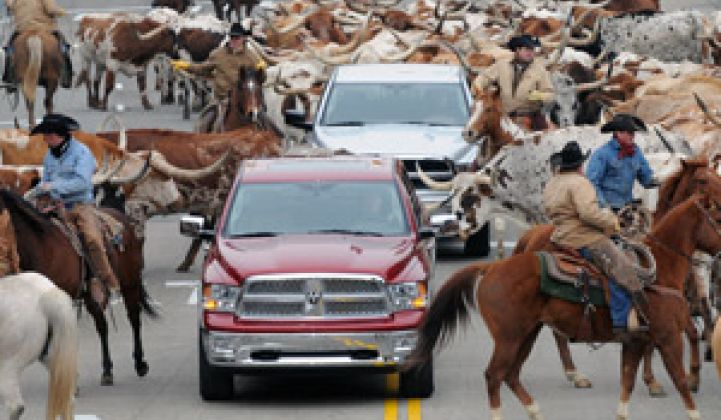A herd of 120 longhorn cattle driven by 10 cowboys on horseback paraded down Washington Boulevard in downtown Detroit on Sunday to help kick off the North American International Auto Show.
The spectacle was Chrysler's attempt to bring attention to its 2009 Dodge Ram, which debuted at the show, and allowed the car manufacturer to release a press announcement with the headline "All-new 2009 Dodge Ram Breaks From the Herd -- Literally."
The media stunt is an example of the lengths to which car manufacturers are going to get attention in tough economic times. It also highlights a new industry strategy, as car manufacturers turn to green technologies to distinguish themselves from the crowd.
Booths throughout the show tout "fuel efficiency" and "low emissions."
General Motors began a press conference debuting its Saturn two-mode hybrid system Monday with a barely audible rock guitar player alone on stage.
"Oh, I think I've found the problem," said Troy Clarke, president of the company's North American operations, walking on stage and plugging together two extension cords that turned on the stage lights and amps. "That's one way of showing the importance of plugging in. … And we're plugged into our customers."
As for the Dodge Ram, the truck is being offered with the additional choice of a two-mode hybrid powertrain, which Chrysler claims boosts fuel economy by 20 percent from its conventional mode. The company also plans to introduce a Cummins biodiesel engine "after 2009" that it says will improve fuel economy 30 percent.
In addition, Chrysler unveiled three concept electric cars Monday: the Jeep Renegade, a plug-in diesel-electric hybrid that gets 110 miles per gallon; the Dodge Zeo, an all-electric sports car with a 250-mile range and more than 250 horsepower; and the Chrysler ecoVoyager, which is equipped with a hydrogen fuel cell and gets more than 110 mpg with a range of more than 300 miles.
The concepts -- which also include biofabrics and post-consumer recyclable materials - were developed by Envi, a wholly owned electric-vehicle subsidiary Chrysler announced in September.
"These three concepts not only showcase what Chrysler and Envi are doing, but hint at where our brands are going," said Trevor Creed, senior vice president of design at Chrysler, at a press conference at the show Monday. "I think the concepts provide evidence that [we will be providing] many different shades of green for Chrysler customers."
After the press conference, Envi President Lou Rhodes said Envi began working on the designs for these concepts a couple of years ago. He added he hopes to bring these concepts to the market in three to five years, with the ecoVoyager being the farthest away.
"I don't see any one individual technology stopping us going forward," he said. "It's the integration of all of those technologies."
But Nick Cappa, a Chrysler spokesman, said the batteries are the biggest challenge.
"A lot of this depends on the battery technologies," he said. "We need significant jumps. If we can get the battery, we can take the car out of the emissions equation all together."
Unlike Toyota, which also plans to move to lithium-ion batteries but already is testing plug-in hybrids with the nickel-metal-hydride batteries available today, Rhodes said Envi isn't considering using nickel-metal-hydrides for these cars.
"We're not capable of having this weight and size without [lithium-ions]," Rhodes said, gesturing toward the concept cars being shown on stage. Chrysler and Envi are now testing the concepts, not only for technology, but also for market acceptance, Rhodes said.
"Will real-world customers plug in at night?" he asked, adding that the company will have to educate customers so that plugging in cars becomes as automatic as plugging in cell phones.
Rhodes said he's not concerned about the ability of the electrical grid to power all these new cars, once they hit the mainstream, because he thinks recharging will happen at night.
"The electrical network in this country is really sized for peak load, so 95 percent of the time, the electrical infrastructure is underutilized," he said. "We think this is very predictable. We think the average [driver] is going to plug in at night."



